Plan checklist
Barry Marsh and James
31 Feldspar Road, Lake Cecebe
Planting plan created by The Land Between
Schedule A:
Plants & Property
Land Characteristics
This planting plan is designed based on the land characteristics identified during the day of the site visit. Plants are chosen according to the soil and light conditions on your property. The number of plants chosen for each planting compartment takes into account the square metre area of the space, as well as the amount of current vegetation cover. Your property is part of ecoZone: 4b
Land Characteristics by Compartment
| Length | Width | Area | pH | Soil | Moisture | Light | Height | |
|---|---|---|---|---|---|---|---|---|
| A | 0m | 0m | 0m2 | normal | sandy | dry | full sun | any |
| B | 0m | 0m | 0m2 | normal | sandy | dry | partial sun | any |
| C | 0m | 0m | 0m2 | basic | sandy | normal | full sun | max 1.5m |
| 0m | 0m | 0m2 |
Plant Selection Summary
The following shrubs and trees are chosen for their suitability and survivability given the current soil and light conditions in each compartment on your property, as well as preferable features.
| Plant Species | A | B | C | Potted | Bareroot | Wildflower |
|---|---|---|---|---|---|---|
| Black Chokeberry | 3 | 3 | ||||
| Ninebark | 5 | 5 | 10 | |||
| Black Elderberry | 1 | 1 | ||||
| Nannyberry | 2 | 2 | ||||
| Red Maple | 1 | 1 | ||||
| White Pine | 2 | 2 | ||||
| Red Oak | 1 | 1 | ||||
| Black-Eyed Susan | 12 | 12 | ||||
| Butterfly Milkweed | 12 | 4 | 16 | |||
| Green-Headed Coneflower | 11 | 11 | ||||
| Pearly Everlasting | 12 | 12 | 11 | 35 | ||
| Sweet Oxeye | 12 | 12 | ||||
| Bearberry | 4 | 4 | ||||
| Alternate-Leaved Dogwood | 2 | 2 | ||||
| Tamarack | 1 | 1 | ||||
| Wintergreen | 12 | 12 | ||||
| Bunchberry | 12 | 12 | ||||
| Canada Anemone | 12 | 12 | 24 | |||
| Oswego Tea (Red Bergamot) | 12 | 12 | ||||
| Sweet Gale | 6 | 6 | ||||
| White Turtlehead | 24 | 24 | ||||
| Cardinal Flower | 12 | 12 | ||||
| Subtotal | 74 | 72 | 69 | 33 | 0 | 182 |
| Totals | 215 | |||||
Plant Information
The following table summarizes key information about each plant selected for your property.
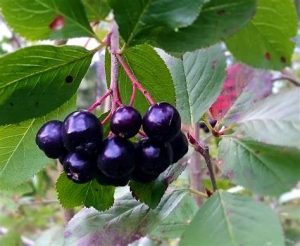
|
Black ChokeberryHeight: 1-3m
The Black Chokeberry is a medium sized deciduous shrub that typically grows between 1-3m with edible fruit. This species requires full sun to partial shade and can tolerate soil conditions from loamy and moist to rocky and dry. Naturally, Black Chokeberry is found in wet wooded areas such as; swamps, along shorelines, and within forest understory. This species is multi-stemmed, and forms thickets from stems which arise from the roots. Leaves are simple, growing alternately along the branch turning a bold red to orange during the fall. During spring, clusters of showy, white flowers appear turning into dark purple berries by fall. This species is resistant to drought, insects, pollution, and disease. The Black Chokeberry is often cultivated as an ornamental plant and food product. Additionally, this species is useful for bank stabilization and erosion control applications.
|
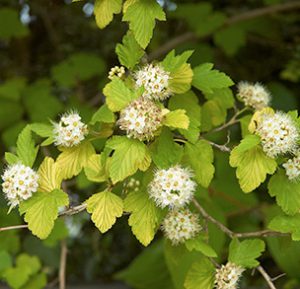
|
NinebarkHeight: 2-3m
The Common Ninebark is a very hardy, large (2-3m in height), deciduous shrub naturally occurring within riparian zones. This species is often planted as an ornamental shrub for its exfoliating bark which reveals reddish-light brown inner bark. This shrub is multi-stemmed with numerous horizontal and ascending branches creating a full, round shape. The Common Ninebark produces dull green, ovate to round shaped leaves with three to five lobes per leaf. During the fall the leaves turn brilliant yellow or dark purple. Between May and June, showy, bell-shaped flowers bloom in clusters on the terminal ends of the branches. During the summer, these flowers give way to small green or green-yellow berries which turn a bright red upon ripening.
|
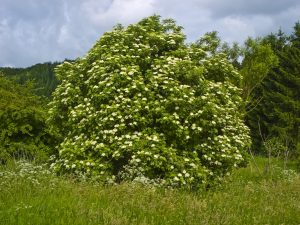
|
Black ElderberryHeight: 4 m
The Black Elderberry is a large, fast-growing, deciduous shrub or small tree, which typically grows to 4m. This species tolerates a variety of conditions and is commonly found in sunny locations with well-drained soils. Black Elderberry can be single or multi-stalked with numerous branches creating a full, round body. Leaves are compound, with 5-7 leaflets that grow opposite each other along the branch. During the fall, leaves tend to turn a pale yellow. During late May to early June, this species produces flowers that are ivory white and grow in flat topped clusters. By late August, flowers turn to glossy, deep purple fruit, which attract a variety of wildlife like songbirds and small mammals. Ripe fruit is edible for humans and is commonly made into jams and jellies. The root system of this species is shallow, and can form colonies through suckering.
|
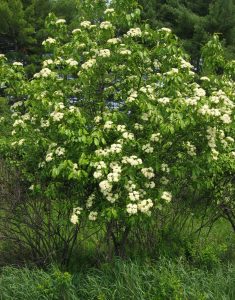
|
NannyberryHeight: 3 m
Nannyberry is a large deciduous shrub species that typically grows about 3 m in height. The leaves are dark green, ovate shaped, oppositely arranged, have a pointed tip, and have finely toothed margins. The flowers are showy, white colored, appear in flat topped clusters, and bloom in May. These flowers produce blueish black berries, which are edible to humans and persist throughout the winter. The flowers are beneficial to pollinator species , like bees and butteries. The fruit is beneficial to wildlife species, including birds and small mammals. This shrub has attractive fall foliage. The root system is extensive, making this plant valuable for controlling erosion and stabilizing loose soil. This shrub can be pruned to have a single stem and grown as a small tree instead of a shrub.
|
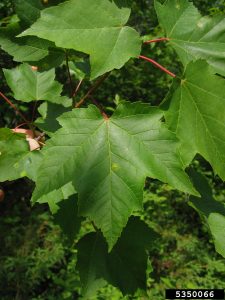
|
Red MapleHeight: 12-25m
The Red Maple is the most common and widespread deciduous tree of Eastern and Central North America. This species can grow 12-25m at maturity. The trunk of this hardwood species is branch free from the base to about halfway up the trunk. When planted in an open area, the trunk can divide and branch out fairly close to the ground. As the tree matures, it develops a short, narrow crown consisting of horizontal and ascending branches. The leaves on the Red Maple grow opposite each other on the branches. During the summer, leaves are bright green on top with a whitish underside. During the fall, the leaves turn a bright red or scarlet colour, from which the name is derived. Prior to leaf development, tree flowers bloom in early May. Red Maple tree flowers are small and red to yellowish orange in colour, growing in clusters on a thin stalk. During June and July, tree flowers develop into reddish winged keys, which hold and disperse seeds. The Red Maple plays an important role in the lumber industry, as its wood is excellent for woodworking.
|
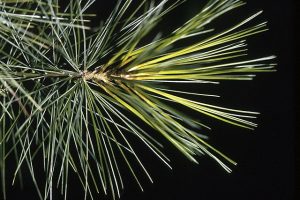
|
White PineHeight: 30m
The White Pine is Ontario's provincial tree. This species is the largest northeastern conifer with soft and light needles, which typically grows 30m in height. The needles are bundled into groups of 5 and are spirally spread around the twigs. White Pine bark is smooth and grey-green when young, becoming dark grey and deeply furrowed upon maturation. This tree produces yellow-green seed cones which are long, cylindrical, and covered in 50-80 scales. Unfortunately, this species is susceptible to White Pine Blister Rust and attacks by the White Pine Weevil. White Pine is a hardy tree which can tolerate a wide range of soil conditions, from sphagnum bogs to dry sandy and rocky ridges.
|
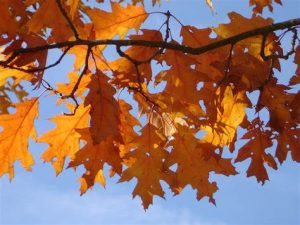
|
Red OakHeight: 30m
The Red Oak, also referred to as the Northern Red Oak or Champion Oak, is a slow growing, hardwood, deciduous tree found throughout Eastern and areas of Central Ontario. This species can grow to be quite tall reaching 30m and has a single, large trunk. The bark is smooth, dark gray in colour, and develops deep ridges with age. The crown of the Red Oak is created by several main branches as well as horizontal and ascending branches. It is uneven and irregular, but generally round in form. Leaves produced are between 10-20 cm long with 7-9 sharp and pointed lobes. During the summer, the leaves are a dull green but in the fall turn a brilliant deep red to yellow-orange. The Red Oak is monoecious, producing male and female flowers on the same tree. Male flowers produced are hanging catkins growing from the leaf axils of the previous year, while the female flowers are grown from the leaf axils of the current year. Fruiting bodies produced by this species are 3 cm long, round shaped acorns with a scaly cap covering a quarter of the body. Red Oak Acorns require approximately two years to reach maturation.
|
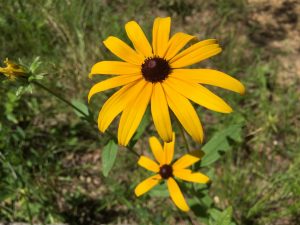
|
Black-Eyed SusanHeight: 1 m
Black-Eyed Susan is a popular biennial or a short-lived perennial wildflower species that typically grows about 1 m in height. Its leaves are green, alternately arranged, lance shaped, and covered with bristly hairs giving the leaf a grey/green colour. The flowers are daisy-like, have 8-20 yellow ray florets surrounding numerous dark brown disk florets, and blooms between June and September. The flowers are beneficial to pollinator species, like bees and butterflies. The seeds are also beneficial to wildlife species, like birds and small mammals. This flower blooms for long periods.
|
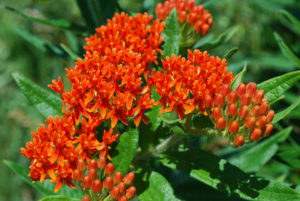
|
Butterfly MilkweedHeight: 0.5 m
Butterfly Milkweed is a very attractive perennial wildflower that typically grows about 0.5 m tall. This plant may also be known by the common name Showy Milkweed. The leaves are green coloured, alternately arranged, narrow and lance-shaped, and have entire margins. The flowers are showy, fragrant, bright orange coloured, have five tiny petals, appear in clusters of 8-25, and bloom between June and August. Butterfly Milkweed is easy to grow and is low maintenance. This wildflower spreads well and can be used to naturalize un-vegetated areas. The roots can be useful for controlling erosion and stabilizing shorelines. The flowers are beneficial to pollinator species, like bees and butterflies. It is also a larval host for caterpillars of the endangered Monarch Butterfly, thus planting this species where possible can help protect this at risk species.
|
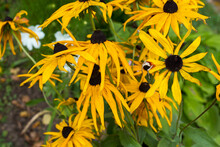
|
Green-Headed ConeflowerHeight: 2.5m
Green-Headed Coneflower is a perennial wildflower that grows from 1-2.5 m in height. The stem is light green, smooth, cylindrical, and branches occasionally. The leaves alternate along the stem and can grow up to 30 cm long and 30 cm wide. The leaf stems are narrow, which gives the leaves a tendency to droop. The lower to middle leaves have 3-7 large lobes and smooth to highly toothed edges. The leaves tend to change in shape depending on how large they grow; but are usually elliptic to ovate in shape. The uppermost leaves on the flowering stalks are much smaller in size and lanceolate to ovate in shape without lobes. The upper leaf surface is dark green and hairless while the lower leaf surface is pale-medium green and sparingly hairy. The stems terminate with clusters of yellow flowers that each have their own stalk up to 5 cm in length. The flowers are 5-8 cm across and have a round center with 6 to 12 yellow petals. The central cone is light green while immature, but it later changes to a yellow colour, resembling a pincushion because of its tubular disk florets that all come out of the cone. Each disk floret is replaced by a 3-4.5 mm, hard, oblong shaped seed pod that has a crown of tiny blunt teeth at its apex. Green-Headed Coneflower prefers moist soils and partial sun. It can be found growing naturally in wet open forests, moist meadows, forest edges, moist thickets, river banks, lake shorelines, and pastures. This wildflower is tolerant of slow-draining, clay-heavy soils. The root system is fibrous and forms clusters that spread through underground rhizomes, which makes this plant great for erosion control, as it will spread and stabilize the soil. Many pollinators are attracted to the Green-Headed Coneflower including bees, wasps, butterflies, skippers, moths, and various kinds of flies. Several insects and animals use the plant for food, including Golden Glow Aphids, Silvery Checkerspot Butterflies, Tortricid Moths, Wavy-Lined Emerald Moth, and Common Pug Moth. Additionally, some bird species like Common Goldfinches feed on the seeds of Green-Headed Coneflower.
|
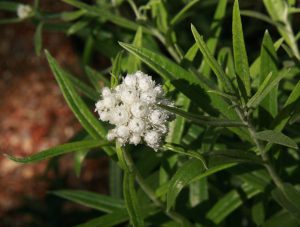
|
Pearly EverlastingHeight: 1m
Pearly Everlasting is a medium sized wildflower species which grows up to 1 m in height. The leaves are grey-green, long and narrow, simple, and alternately arranged. The flowers are small, white colored with yellow centers, have silvery hue appearance, appear in attractive clusters, and bloom between July and August. It is also a great attractant for the American Lady Butterfly because it is a host for its larvae. Historically, Pearly Everlasting was used as a salve to treat burns, bruises, swelling, and joint pain.
|
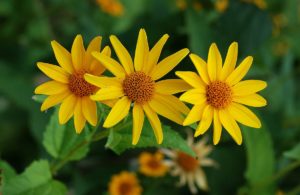
|
Sweet OxeyeHeight: 2m
Sweet Oxeye, also known as False Sunflower, is an attractive, herbaceous, perennial wildflower, which can grow to almost 2 m tall. The flowers are perched atop a stiff stem, with a brownish-yellow center cone surrounded by bright yellow to orange rays. Leaves are 5-12 cm long and 2-8 cm wide, oppositely arranged along the stem, ovate to lanceolate in shape, and have a toothed margin. This wildflower grows best in moist, well-drained soils, preferring full sun, but will tolerate partial shade. Some common natural habitats for the Sweet Oxeye are prairies, meadows, forest edges, and stream banks. Sweet Oxeye is drought tolerant so could be planted in difficult dry sites, but will grow best with regular watering. A large variety of insect species are attracted to the Sweet Oxeye, making it a great addition to a habitat garden.
|
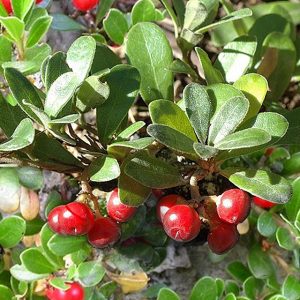
|
BearberryHeight: 20 cm
Bearberry is a low growing, evergreen shrub/ground cover species that grows about 20 cm tall. The leaves are dark green, leathery, shiny, ovate shaped, alternately arranged, and have entire margins. The flowers are tiny, urn shaped, white to pink colored, appear in drooping clusters, and bloom between April and May. Flowers are followed by bright red berries, which remain throughout the fall and winter. These berries are beneficial to wildlife species like birds and small mammals.
|
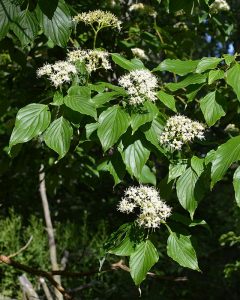
|
Alternate-Leaved DogwoodHeight: 5-10 m
The Alternate-Leaved Dogwood is a tall, deciduous shrub or small tree species that can grow 5-10 m in height. This plant may also be known by the common name Pagoda Dogwood. It can be grown either in the form of a single stem tree or multi-stemmed shrub comprised of two or three smaller trunks. The leaves are ovate shaped, alternately arranged, have prominent veins, have a pointed tip, and have entire margins. The flowers are showy, fragrant, whitish yellow, appear in flat clusters, and bloom between May and June. These flowers produce clusters of dark blue berries. The flowers are beneficial for pollinator species while the berries are beneficial for wildlife species. The root system is valuable for controlling erosion and stabilizing loose soil. This plant is often used as a small ornamental tree in landscaping. The common name comes from the fact that all other Dogwood species have oppositely arranged leaves.
|
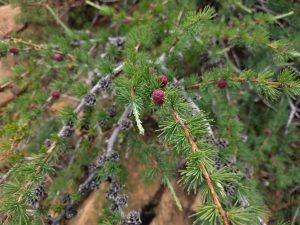
|
TamarackHeight: 20 m
Tamarack is a small to medium sized, deciduous coniferous tree species that grows up to 20 m tall. This plant may also be known by the common name American Larch. The bark is scaly and reddish brown coloured. The needles are delicate, 2-4 cm long, blueish-green coloured, grow in clusters of 15 to 25, and change golden yellow in the fall. This tree provides food and habitat for wildlife species, including birds and mammals. Tamarack is a fast-growing, long lived species that can live up to 150 years and is found across all of Canada. The wood from this tree is decay-resistant and has been used to make railway ties, posts, and crates. Tamarack is considered unique because it is the only conifer species to drop its needles in the fall.
|
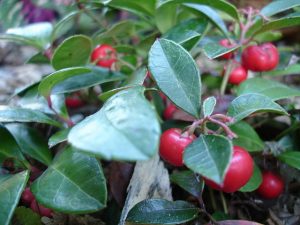
|
WintergreenHeight: 15 cm
Wintergreen is a medium-sized ground cover species that grows up to 15 cm in height. The leaves are glossy, dark-green, simple, oval shaped, and turn purple during the fall. Wintergreen is a visually appealing plant that produces small, white, bell-shaped flowers during the spring. This species yields edible, scarlet red berries during July, which persist throughout the winter months. These berries are a great food source for many song birds, squirrels, deer and a tasty treat for humans when added to pastries or salads. The name Wintergreen comes from the plants ability to keep it's leaves throughout the winter. Wintergreen is unique because their leaves emit a minty aroma when crushed. Wintergreen oil is commonly used in the flavoring of gum and toothpaste.
|
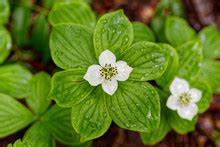
|
BunchberryHeight: 15 cm
Bunchberry is a deciduous ground cover species that can grow around 15 cm in height. This plant may also be known by the common name Creeping-Dogwood. The leaves are deep green, oppositely arranged, oval shaped, and glossy. The flowers are showy, white colored, and bloom between May and June. These flowers produce bright red berries that are edible to humans and beneficial to wildlife species, like birds and small mammals.
|
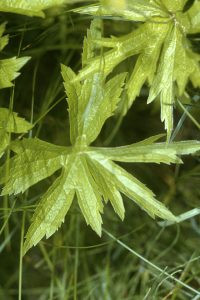
|
Canada AnemoneHeight: 50 cm
Canada Anemone is a perennial wildflower species that typically grows about 50 cm tall. This plant may also be known by the common names Meadow Anemone or Roundleaf Anemone. The leaves are basal, dark green, deeply divided into 3-5 lobes with 2-3 sub-lobes, have prominent veins, and have toothed margins. The flowers are showy, white colored, have 5 petal-like sepals, have yellow center stamens, appear on erect hairy stems, and bloom between April and June. After blooming, the flowers are replaced by a cluster of achenes that are 4-6 mm in size, hairy, and slightly flattened. These wildflowers are tolerant of juglone, a toxic compound that is naturally produced by plants in the Walnut family, like Walnut, Pecan, and Hickory trees. This wildflower is beneficial for pollinator species, like bees and butterflies. This plant spreads quickly through rhizomes and can be valuable for re-vegetating large areas as a ground cover.
|
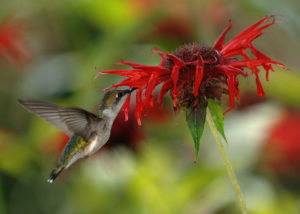
|
Oswego Tea (Red Bergamot)Height: 50 cm
Oswego Tea is a showy perennial wildflower species that typically grows about 50 cm in height. This plant may also be known by the common names Red Bergamot or Scarlet Beebalm. The leaves are dark green, oval shaped, have a minty fragrance. The unique flowers are bright red and grow in dense rounded clusters, with individual tubular flowers that bloom between May and October. The beautiful flowers of Oswego Tea attract various pollinator species like hummingbirds, butterflies, and bees. The Oswego Tea plant is susceptible to a common fungal disease, called powdery mildew, when planted in dry soils. Historically, the leaves of the plant have been used for antiseptic purposes, as well as poultices to heal minor wounds and skin infections.
|
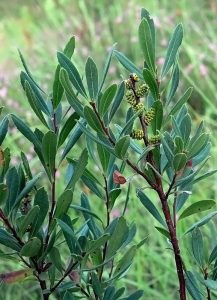
|
Sweet GaleHeight: 1-2m
Sweet Gale is a medium-sized shrub which grows into a thick bush about 1-2 m tall. This species produces 1-8 cm long, oblong-lanceolate leaves which are finely toothed at the tip and are spirally arranged. When bruised, these leaves give off a pleasant aroma. Male and female catkins are produced on separate plants. The seeds are dispersed from the female plants via water, as they float on two corky bracts. This shrub also provides a good food source for bird species that eat the seeds including Grouse, Chickadees, and Bluebirds. Mammal species like Beavers and White-Tailed Deer also browse on the twigs and leaves of this plant.
|
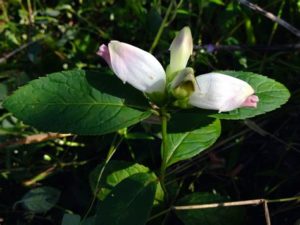
|
White TurtleheadHeight: 1 m
White Turtlehead is a beautiful wildflower species that can grow up to 1 m in height and spreads about 0.5 m. The leaves are oppositely arranged, dark green coloured, short-stalked, lance-shaped, and have sharply toothed margins. The flowers are whitish pink coloured, shaped like a turtle's head, made of two lips creating a tube, appear in dense spikes at the tip of erect stems, and bloom between August and October. The flowers are beneficial to pollinator species, like bees and butterflies.
|
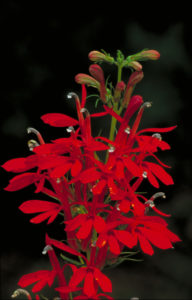
|
Cardinal FlowerHeight: 1 m
Cardinal Flower is an attractive herbaceous perennial wildflower that can grown up to 1 m tall. The leaves are mostly basal, dark green, lance shaped, alternately arranged, and have finely toothed margins. The flowers are showy, bright cardinal red colored, tubular with five lips, appear on an erect terminal spike, and bloom between July and September. The flowers are beneficial for pollinator species, like butterflies and hummingbirds. This is a popular plant choice for wet shoreline properties because of its visual appeal and ornamental value.
|
Compartment A
Naturalization Area
Move flacks from shore to create structure and beauty within the planting area pH: normal
pH: normal Depth: potted, wildflowers
Depth: potted, wildflowers-
 Moisture: dry
Moisture: dry -
 Soil Type: sandy
Soil Type: sandy  Plant Height: any
Plant Height: any-
 Light conditions: full sun
Light conditions: full sun
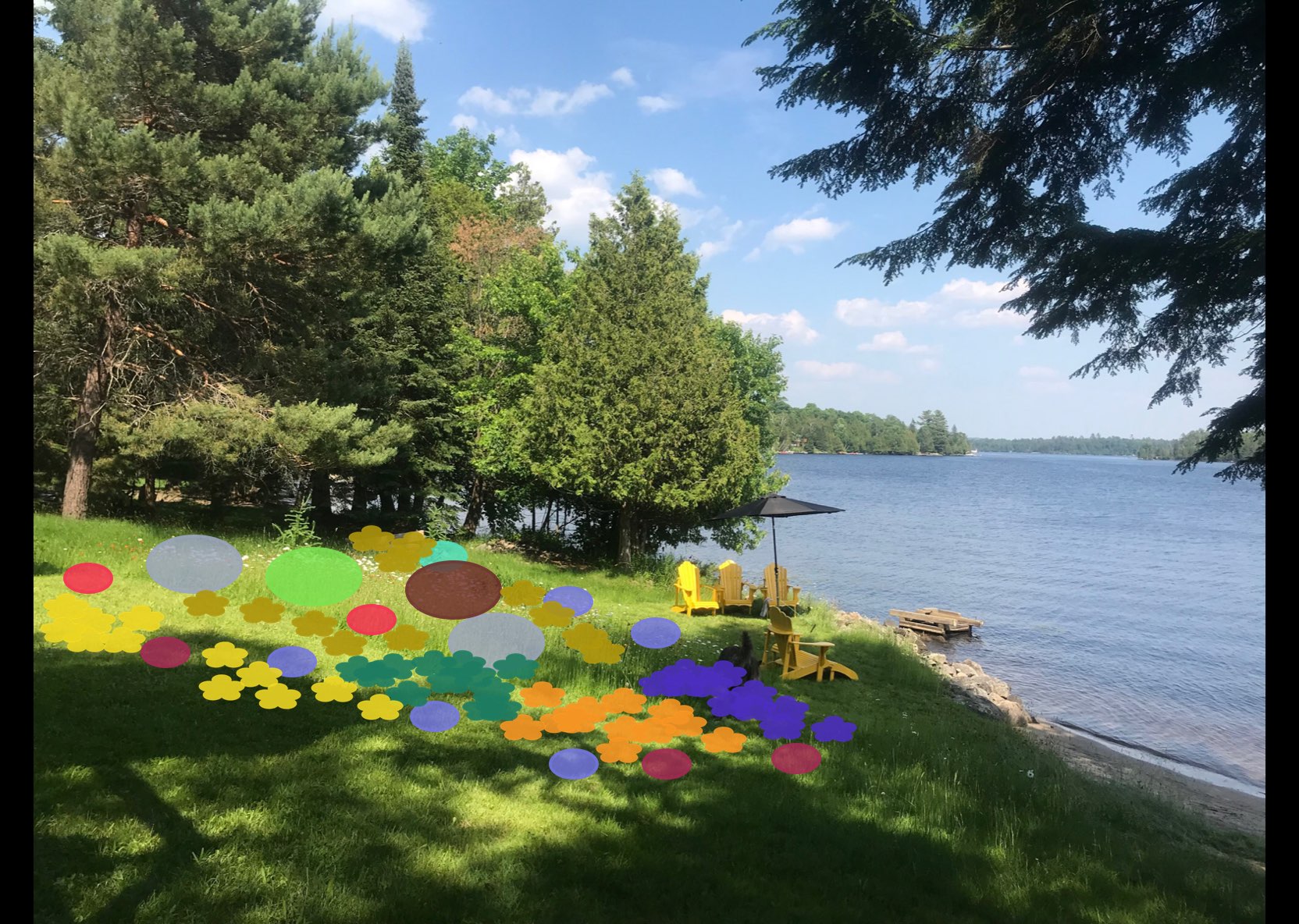
Compartment B
Naturalization Area
Tamarack from side garden to be replanted here pH: normal
pH: normal Depth: wildflowers
Depth: wildflowers-
 Moisture: dry
Moisture: dry -
 Soil Type: sandy
Soil Type: sandy  Plant Height: any
Plant Height: any-
 Light conditions: partial sun
Light conditions: partial sun
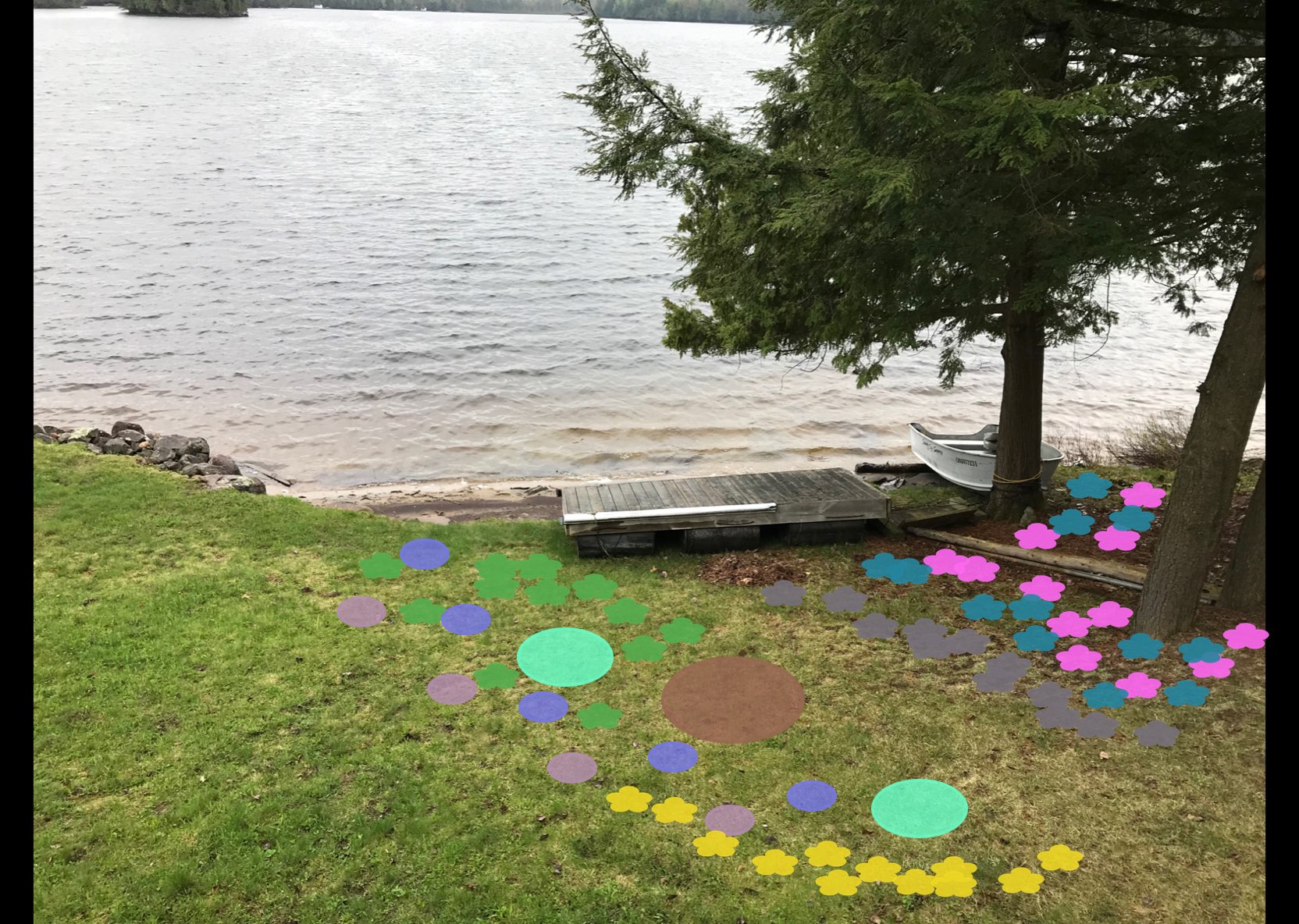
Compartment C
Naturalization Area
Reduce slopes of rock to 30 degrees and place in other planting compartment. Also allow roots of sweet gale to reach water between rocks- plant them in between remaining rocks along shore pH: basic
pH: basic Depth: wildflowers
Depth: wildflowers-
 Moisture: normal
Moisture: normal -
 Soil Type: sandy
Soil Type: sandy  Plant Height: max 1.5m
Plant Height: max 1.5m-
 Light conditions: full sun
Light conditions: full sun
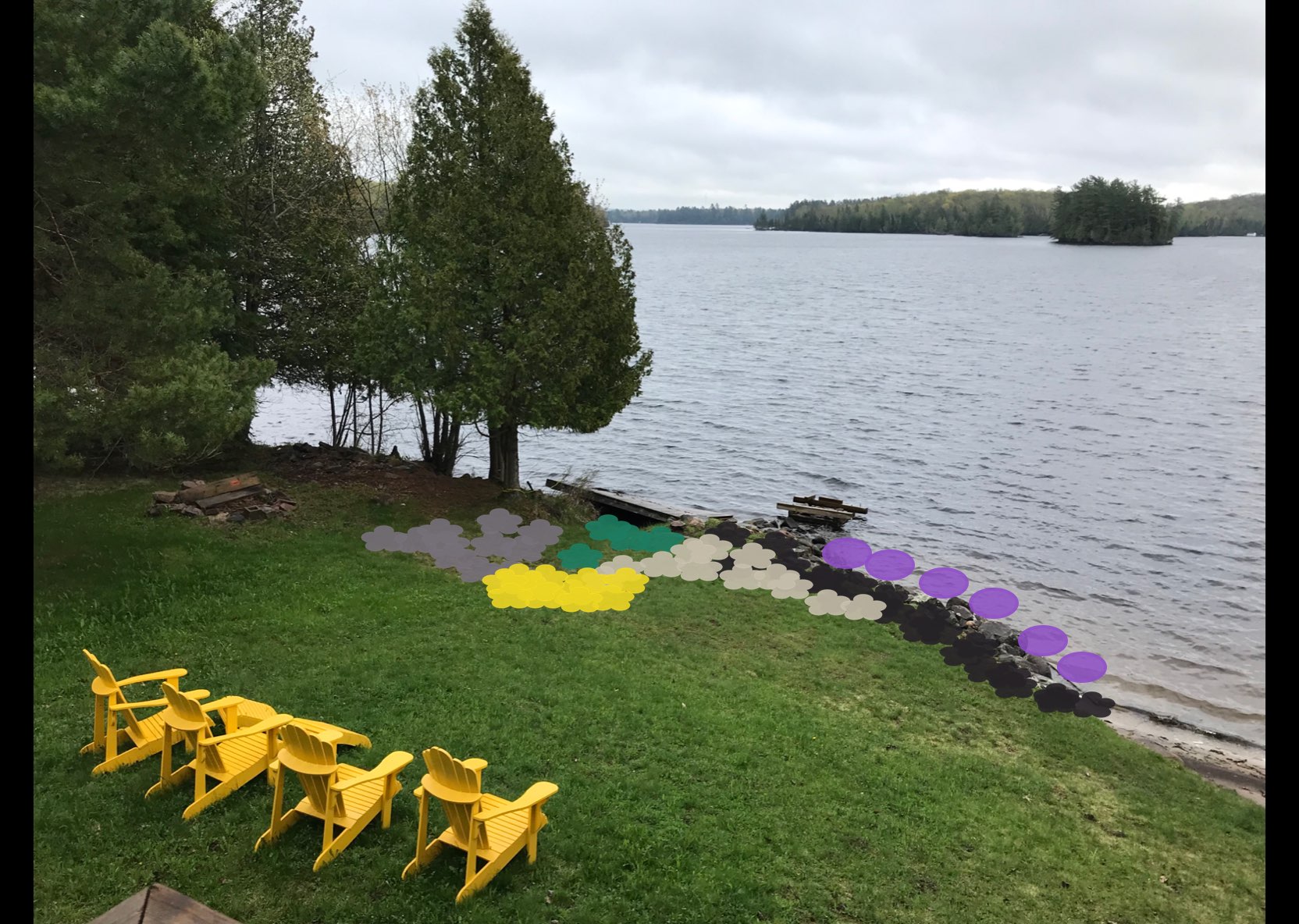
Schedule B
Financial Summary
Project by: The Land Between
Shoreline Re-Naturalization Starter Kit includes: free site visit, customized re-naturalization planting plan for your shoreline property, native plants including free bare root (small) and potted (large) plants and wildflowers, coconut fibre pads to deter grass from growing around new plantings, tree guards for all deciduous trees, mulch for your wildflowers, Plant Care Guide with instructions on how to take care of your new plants, Habitat Creation Guide and a Wildflower Garden Guide.
Our planting plans are created onsite with you and provide detailed information and plans to re-naturalize your shoreline property. We take photos of areas for planting and overlay native plants that are well suited to your property based on site conditions such as soil type and sunlight availability.
We will work with you to create a plan that works for you including options for low growing plants in areas where views are important.
| Item | Quantity | Cost/Item | Subtotal |
|---|---|---|---|
| Starter Kit fee | $250 | ||
| Free potted plants | 10 | $0 | $0 |
| Paid potted plants | 23 | 13.00 | 299.00 |
| Free bareroot plants | 0 | $0 | $0 |
| Free wildflowers | 25 | $0 | $0 |
| Paid wildflowers | 157 | 7.00 | 1099.00 |
| Total costs | 1648.00 |
Schedule C
Project Agreement
Stewardship Agreement
Please indicate your agreement to this proposed plan by signing the following Stewardship Agreement and submitting it, along with your financial contribution, to:
The Land Between
Box 1368, Haliburton, Ontario, K0M 1S0
Plant Availability
Please note that plant species may need to be changed based on plant stock availability at the time of ordering.
Project Completion
Upon receiving your signed stewardship agreement and financial contribution, a date will be booked for you to pick up your Natural Edge Kit. The Land Between will supply all plants and materials. If you are paying for the planting to be completed for you, a date will be arranged for The Land Between to plant your shoreline, bringing the plants and materials with them. If there are particular dates that you would prefer, we will do our best to accommodate your requests.
The Natural Edge Stewardship Agreement with The Land Between
Agreement made this Day of the Month of in the Year .
BETWEEN Barry Marsh 31 Feldspar Road Burks Falls Ontario (Hereinafter called the OWNERS)
AND The Land Between Box 1368, Haliburton, Ontario, K0M 1S0 (Hereinafter called TLB)
WHEREAS the Owners and TLB have met and discussed plans for shoreline naturalization on the specified area(s) in Schedule A existing on the Owners’ land;
WHEREAS the Owners indicate approval of the project as proposed; and
WHEREAS the project is, or will be for the benefit of the Owners and others;
NOW THEREFORE THE PARTIES AGREE AS FOLLOWS:
1. This Agreement shall be in effect for a period of 5 years, commencing with the date of this Agreement.
2. The Owners and TLB agree that the areas where the work is to be performed is as described in Schedule A.
3. The Owners agree to pick up their Natural Edge Starter Kit from TLB’s office and plant their shoreline within two days of receipt. The Owners will provide “after” photos of the work completed to be used for reporting purposes. If the Owners wish to have the planting completed for them, then TLB or it’s contractors, employees and agents will complete the planting at cost, as indicated in Schedule B.
4. If the planting is to be completed by TLB, then the Owners grant TLB, its contractors, employees and agents, the right to enter the property to perform the work agreed upon as outlined in Schedule A. In addition, TLB, its contractors, employees and agents may inspect the work performed for the purposes of monitoring the project and survival assessment, with prior agreement with Owners for date and time of inspection.
5. The Owners agree to contribute the “Landowner contribution” and pay the costs indicated in Schedule B.
6. In instances where the Owners are to pay TLB for work to be performed (outlined in Schedule A), the Owners agree to provide payments to TLB prior to the commencement of that operation. Failure of payment shall constitute a breach of this Agreement and the Owners agree that this Agreement will be terminated and thereupon the Owners agree to pay TLB the estimated costs of the operations of the project completed to date, if any.
7. The Owners agree, if necessary, to perform a reasonable amount of maintenance, which is described in the Native Plant Care Guide, available at naturaledge.watersheds.ca.
8. If a contractor is required to perform the work outlined in Schedule A, then the contractor carrying out the work on the land described will be required to take out and furnish evidence of a comprehensive policy of public liability and property damage coverage. The contractor and their workers will be required to be in good standing with the Workplace Safety and Insurance Board (WSIB) prior to performing the work.
9. The Owners agree not to remove, destroy or alter the project without prior consultation and approval of TLB. Pruning and trimming planted nursery stock, or adding replacement native nursery stock is exempt.
10. The Owners agree not to mow the planted area.
11. The Owners do acknowledge that TLB, its contractors, employees and agents, having performed said works, are not under further obligation with respect to survival of nursery stock, inspection, or maintenance.
12. The Owners, in the absence of negligence, hereby remise, release and forever discharge TLB, its contractors, employees and agents from all claims and demands for injuries, including death, loss, damages and costs in any way related to or connected with installation and maintenance of the work described or resulting from any deleterious effects of the work to the land or to the lands and buildings thereon retained by the Owners.
IN WITNESS WHEREOF the parties have agreed to the contents of this plan; SIGNED:
About this program
About The Land Between
The Land Between is Cottage Country's Conservation Organization. We are a grassroots non-govermennt organization that works to preserve and restore the natural, cultural and socio-economic features of this unique and irreplaceable region in Ontario
This program was created by Watersheds Canada
We believe that every person has the right to access clean and healthy lakes and rivers in Canada. At Watersheds Canada, we work to keep these precious places naturally clean and healthy for people and wildlife to continue using for years to come. We love working with others to meet the needs of local communities, whether you’re a concerned citizen, a landowner, a lake association looking for help, or a coalition of groups interested in activating your local community.

